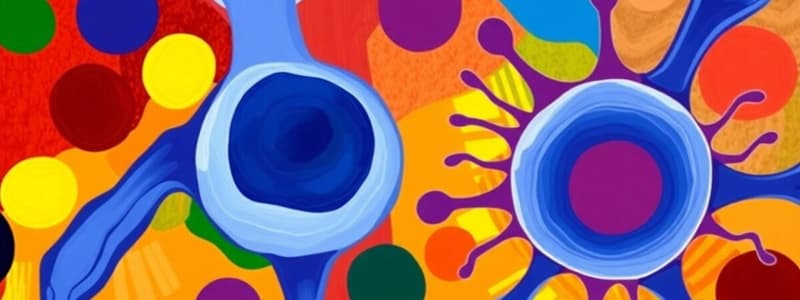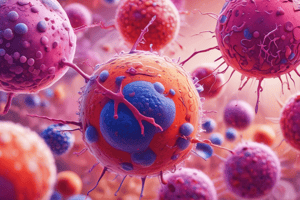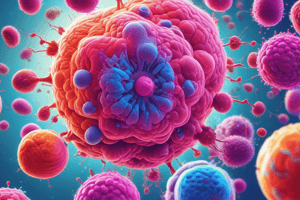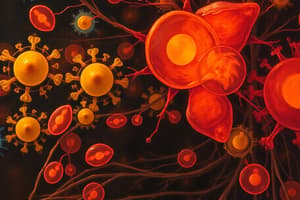Podcast
Questions and Answers
Which statement best describes the functional interplay between dendritic cells (DCs) and T cells within the periarteriolar lymphoid sheath (PALS) of the spleen?
Which statement best describes the functional interplay between dendritic cells (DCs) and T cells within the periarteriolar lymphoid sheath (PALS) of the spleen?
- DCs in the PALS directly activate B cells, which then stimulate T cell proliferation through cytokine release.
- DCs, after encountering antigens, migrate to the PALS to present these antigens to T cells, initiating adaptive immune responses. (correct)
- The PALS serves as the primary site for T cell differentiation into NK cells, facilitated by the cytokine environment created by resident DCs.
- T cells within the PALS phagocytose pathogens, which are then presented to DCs for subsequent antigen presentation to B cells.
A researcher is investigating the immune response in the gut-associated lymphoid tissue. Which of the following characteristics is unique to Peyer's patches compared to other secondary lymphoid organs?
A researcher is investigating the immune response in the gut-associated lymphoid tissue. Which of the following characteristics is unique to Peyer's patches compared to other secondary lymphoid organs?
- Antigen uptake directly from the lumen via M cells. (correct)
- Presence of HEVs allowing lymphocyte entry.
- Drainage via efferent lymphatic vessels.
- Housing of DCs, T cells, and B cells in distinct zones.
Following a severe bacterial infection, a patient's blood work reveals a significantly elevated neutrophil count. Considering the characteristics of neutrophils, which of the following is the most likely consequence of this surge in neutrophil activity?
Following a severe bacterial infection, a patient's blood work reveals a significantly elevated neutrophil count. Considering the characteristics of neutrophils, which of the following is the most likely consequence of this surge in neutrophil activity?
- Resolution of the infection site, followed by the development of immunological memory.
- Long-term enhancement of antibody production by plasma cells.
- Localized tissue damage due to the release of granular enzymes and reactive oxygen species. (correct)
- Increased risk of allergic reactions due to histamine release.
In the context of innate immune responses against viral infections, how do Natural Killer (NK) cells differentiate between healthy cells and infected cells, enabling them to selectively target and destroy the latter?
In the context of innate immune responses against viral infections, how do Natural Killer (NK) cells differentiate between healthy cells and infected cells, enabling them to selectively target and destroy the latter?
A researcher is studying the role of macrophages in maintaining homeostasis within the spleen. Which specific function of splenic macrophages is most critical for preventing systemic complications associated with chronic infections and autoimmune disorders?
A researcher is studying the role of macrophages in maintaining homeostasis within the spleen. Which specific function of splenic macrophages is most critical for preventing systemic complications associated with chronic infections and autoimmune disorders?
Which of the following scenarios would most likely result in a thymocyte undergoing apoptosis during T cell development in the thymus?
Which of the following scenarios would most likely result in a thymocyte undergoing apoptosis during T cell development in the thymus?
AIRE's (autoimmune regulator) primary role in T cell development is to:
AIRE's (autoimmune regulator) primary role in T cell development is to:
A researcher identifies a genetic defect that prevents thymocytes from upregulating both CD4 and CD8. At which stage of T cell development would this defect have the most immediate impact?
A researcher identifies a genetic defect that prevents thymocytes from upregulating both CD4 and CD8. At which stage of T cell development would this defect have the most immediate impact?
During T cell development, a thymocyte is positively selected. Which of the following is the most direct consequence of this positive selection?
During T cell development, a thymocyte is positively selected. Which of the following is the most direct consequence of this positive selection?
If a developing thymocyte fails to express a T cell receptor (TCR) with sufficient binding strength to self-peptide:self-MHC complexes, what is the most likely outcome?
If a developing thymocyte fails to express a T cell receptor (TCR) with sufficient binding strength to self-peptide:self-MHC complexes, what is the most likely outcome?
Which scenario would most likely result from a defective TH1 response?
Which scenario would most likely result from a defective TH1 response?
What is the primary mechanism by which TH2 cells help to eliminate helminth infections?
What is the primary mechanism by which TH2 cells help to eliminate helminth infections?
Which of the following best describes how TH1-activated macrophages combat intracellular pathogens?
Which of the following best describes how TH1-activated macrophages combat intracellular pathogens?
Why are anti-histamines effective in alleviating allergy symptoms?
Why are anti-histamines effective in alleviating allergy symptoms?
What is the role of IL-17 secreted by TH17 cells in coordinating a type 3 immune response?
What is the role of IL-17 secreted by TH17 cells in coordinating a type 3 immune response?
How do memory T cells differ from naive T cells in their trafficking patterns?
How do memory T cells differ from naive T cells in their trafficking patterns?
What is the significance of IL-7 and IL-15 in the context of immunologic memory?
What is the significance of IL-7 and IL-15 in the context of immunologic memory?
How do effector T cells adapt to different immunological challenges, particularly in type 3 responses?
How do effector T cells adapt to different immunological challenges, particularly in type 3 responses?
In the context of lymphocyte trafficking, what determines where effector T cells home after activation?
In the context of lymphocyte trafficking, what determines where effector T cells home after activation?
What is the primary advantage of immunologic memory compared to the initial adaptive immune response?
What is the primary advantage of immunologic memory compared to the initial adaptive immune response?
Why is the adaptive immune system considered advantageous compared to the innate immune system, despite its slower response time?
Why is the adaptive immune system considered advantageous compared to the innate immune system, despite its slower response time?
How do dendritic cells facilitate the adaptive immune response?
How do dendritic cells facilitate the adaptive immune response?
If a patient has a deficiency in MHC class I molecules, which immune cells would be most directly affected in their ability to function?
If a patient has a deficiency in MHC class I molecules, which immune cells would be most directly affected in their ability to function?
How does the structure of an antibody contribute to its function in the adaptive immune response?
How does the structure of an antibody contribute to its function in the adaptive immune response?
What is the significance of lymphocyte recirculation between blood and lymph nodes in adaptive immunity?
What is the significance of lymphocyte recirculation between blood and lymph nodes in adaptive immunity?
How does the recognition of antigens by T cell receptors (TCRs) differ fundamentally from that of antibodies?
How does the recognition of antigens by T cell receptors (TCRs) differ fundamentally from that of antibodies?
In the context of adaptive immunity, what is the role of the high endothelial venules (HEV) found in the paracortical area of lymph nodes?
In the context of adaptive immunity, what is the role of the high endothelial venules (HEV) found in the paracortical area of lymph nodes?
Considering the different categories of pathogens, why is it crucial for the immune system to have diverse mechanisms for defense?
Considering the different categories of pathogens, why is it crucial for the immune system to have diverse mechanisms for defense?
How does vaccination contribute to the development of adaptive immunity against specific pathogens?
How does vaccination contribute to the development of adaptive immunity against specific pathogens?
What is the functional implication of the location of B cell follicles in the outermost cortex and T cell zones in the paracortex of a lymph node?
What is the functional implication of the location of B cell follicles in the outermost cortex and T cell zones in the paracortex of a lymph node?
How do antibodies neutralize pathogens to prevent infection?
How do antibodies neutralize pathogens to prevent infection?
What role do cytokines and chemokines play in the innate immune response following the detection of PAMPs?
What role do cytokines and chemokines play in the innate immune response following the detection of PAMPs?
How does the architecture of the inner medulla of a lymph node support the adaptive immune response?
How does the architecture of the inner medulla of a lymph node support the adaptive immune response?
What is the primary function of pattern recognition receptors (PRRs) in the innate immune system?
What is the primary function of pattern recognition receptors (PRRs) in the innate immune system?
How would a deficiency in common myeloid progenitors impact the immune system's ability to respond to pathogens?
How would a deficiency in common myeloid progenitors impact the immune system's ability to respond to pathogens?
How does the co-receptor CD4 or CD8 enhance T cell receptor (TCR) signaling?
How does the co-receptor CD4 or CD8 enhance T cell receptor (TCR) signaling?
Which of the following mechanisms is NOT directly involved in turning off or downregulating signaling pathways initiated by receptor tyrosine kinases?
Which of the following mechanisms is NOT directly involved in turning off or downregulating signaling pathways initiated by receptor tyrosine kinases?
What is the primary role of scaffold proteins in signal transduction pathways?
What is the primary role of scaffold proteins in signal transduction pathways?
How does Cyclosporin exert its immunosuppressive effects at the molecular level?
How does Cyclosporin exert its immunosuppressive effects at the molecular level?
Which of the following processes is most directly affected by inhibiting the function of phospholipase C-γ (PLC-γ) in T cells?
Which of the following processes is most directly affected by inhibiting the function of phospholipase C-γ (PLC-γ) in T cells?
A researcher discovers a novel protein that binds specifically to phosphorylated ITIM domains. What is the most likely function of this protein?
A researcher discovers a novel protein that binds specifically to phosphorylated ITIM domains. What is the most likely function of this protein?
How does the pre-B cell receptor (pre-BCR) signal to enforce allelic exclusion and prevent the expression of multiple BCRs on a single B cell?
How does the pre-B cell receptor (pre-BCR) signal to enforce allelic exclusion and prevent the expression of multiple BCRs on a single B cell?
A developing B cell in the bone marrow strongly binds to a self-antigen. Which of the following outcomes is LEAST likely to occur as a result of this interaction?
A developing B cell in the bone marrow strongly binds to a self-antigen. Which of the following outcomes is LEAST likely to occur as a result of this interaction?
Mature T cells require a co-stimulatory signal in addition to antigen presentation via MHC to become fully activated. Which of the following scenarios would most likely lead to T cell anergy rather than activation?
Mature T cells require a co-stimulatory signal in addition to antigen presentation via MHC to become fully activated. Which of the following scenarios would most likely lead to T cell anergy rather than activation?
What distinguishes the signaling pathways of the B cell receptor (BCR) from those of the T cell receptor (TCR)?
What distinguishes the signaling pathways of the B cell receptor (BCR) from those of the T cell receptor (TCR)?
How does CTLA-4 function as a checkpoint inhibitor in T cell activation?
How does CTLA-4 function as a checkpoint inhibitor in T cell activation?
Rapamycin, an mTOR inhibitor, is used to prevent transplant rejection. Which of the following cellular processes is most directly inhibited by rapamycin?
Rapamycin, an mTOR inhibitor, is used to prevent transplant rejection. Which of the following cellular processes is most directly inhibited by rapamycin?
Which step in T cell development is most affected by DiGeorge's syndrome, a condition resulting from the failure of the thymus to develop properly?
Which step in T cell development is most affected by DiGeorge's syndrome, a condition resulting from the failure of the thymus to develop properly?
What role do stromal cells play in B cell development within the bone marrow?
What role do stromal cells play in B cell development within the bone marrow?
Which of the following events within the immunological synapse enables targeted cytokine release and effective signaling between T cells and antigen-presenting cells?
Which of the following events within the immunological synapse enables targeted cytokine release and effective signaling between T cells and antigen-presenting cells?
Which of the following mechanisms is LEAST likely to contribute to tissue damage during an intracellular bacterial infection?
Which of the following mechanisms is LEAST likely to contribute to tissue damage during an intracellular bacterial infection?
How does the structure of MBL (mannose-binding lectin) contribute to its function in the lectin pathway of complement activation?
How does the structure of MBL (mannose-binding lectin) contribute to its function in the lectin pathway of complement activation?
In the context of the alternative pathway of complement activation, what prevents widespread complement activation on host cell surfaces?
In the context of the alternative pathway of complement activation, what prevents widespread complement activation on host cell surfaces?
Why is the disruption of the intestinal barrier function a critical factor in the pathogenesis of Crohn's disease?
Why is the disruption of the intestinal barrier function a critical factor in the pathogenesis of Crohn's disease?
How do epithelial cells in the lungs contribute to innate immunity, and what distinguishes their function from that of goblet cells?
How do epithelial cells in the lungs contribute to innate immunity, and what distinguishes their function from that of goblet cells?
Which of the following is NOT a recognized outcome following C3 cleavage during complement activation?
Which of the following is NOT a recognized outcome following C3 cleavage during complement activation?
What is the significance of the leucine-rich repeats (LRR) found in the extracellular region of Toll-like receptors (TLRs)?
What is the significance of the leucine-rich repeats (LRR) found in the extracellular region of Toll-like receptors (TLRs)?
How does Staphylococcus aureus evade the complement system, and what is the practical implication of this mechanism?
How does Staphylococcus aureus evade the complement system, and what is the practical implication of this mechanism?
What distinguishes the activation mechanism of NLRP3 from that of NOD2 in cytosolic PRRs?
What distinguishes the activation mechanism of NLRP3 from that of NOD2 in cytosolic PRRs?
How do RIG-I-like receptors (RLRs) discriminate between self and non-self RNA in the cytosol, and what is the outcome of their activation?
How do RIG-I-like receptors (RLRs) discriminate between self and non-self RNA in the cytosol, and what is the outcome of their activation?
Considering the role of cGAS/STING in innate immunity, what would be the MOST likely consequence of a loss-of-function mutation in the STING protein?
Considering the role of cGAS/STING in innate immunity, what would be the MOST likely consequence of a loss-of-function mutation in the STING protein?
How do chemokines contribute to the extravasation of leukocytes during inflammation, and what is their primary mechanism of action?
How do chemokines contribute to the extravasation of leukocytes during inflammation, and what is their primary mechanism of action?
Explain the significance of co-stimulatory molecules like CD80 and CD86 in the context of adaptive immunity, and what role do adjuvants play in this process?
Explain the significance of co-stimulatory molecules like CD80 and CD86 in the context of adaptive immunity, and what role do adjuvants play in this process?
How does TNF-α contribute to both local containment of an infection and systemic septic shock, and what factors determine which outcome predominates?
How does TNF-α contribute to both local containment of an infection and systemic septic shock, and what factors determine which outcome predominates?
In X-linked Severe Combined Immunodeficiency (X-SCID) caused by mutations in the common γ chain receptor, which of the following immune deficiencies would be LEAST expected?
In X-linked Severe Combined Immunodeficiency (X-SCID) caused by mutations in the common γ chain receptor, which of the following immune deficiencies would be LEAST expected?
Flashcards
Efferent lymphatics
Efferent lymphatics
Exit routes for lymphocytes from lymph nodes.
Spleen red pulp
Spleen red pulp
Part of the spleen involved in red blood cell destruction and disposal.
Dendritic cells
Dendritic cells
Immune cells that phagocytose and activate T lymphocytes after maturation.
NK cells
NK cells
Signup and view all the flashcards
Granulocytes
Granulocytes
Signup and view all the flashcards
Double-negative thymocytes
Double-negative thymocytes
Signup and view all the flashcards
Double-positive cells
Double-positive cells
Signup and view all the flashcards
Positive selection
Positive selection
Signup and view all the flashcards
Negative selection
Negative selection
Signup and view all the flashcards
AIRE function
AIRE function
Signup and view all the flashcards
Edward Jenner
Edward Jenner
Signup and view all the flashcards
Intracellular Bacteria/Protozoa
Intracellular Bacteria/Protozoa
Signup and view all the flashcards
Endotoxins
Endotoxins
Signup and view all the flashcards
Leukocytes
Leukocytes
Signup and view all the flashcards
Immune System Function
Immune System Function
Signup and view all the flashcards
Exotoxins
Exotoxins
Signup and view all the flashcards
Pathogen Categories
Pathogen Categories
Signup and view all the flashcards
Defensins
Defensins
Signup and view all the flashcards
Lysozyme
Lysozyme
Signup and view all the flashcards
Innate Immune System
Innate Immune System
Signup and view all the flashcards
Complement System
Complement System
Signup and view all the flashcards
Adaptive Immune System
Adaptive Immune System
Signup and view all the flashcards
Phagocytosis
Phagocytosis
Signup and view all the flashcards
Antigen-Presenting Cells
Antigen-Presenting Cells
Signup and view all the flashcards
Anaphylatoxins
Anaphylatoxins
Signup and view all the flashcards
Toll-like Receptors (TLR)
Toll-like Receptors (TLR)
Signup and view all the flashcards
Antibodies
Antibodies
Signup and view all the flashcards
NOD-like Receptors (NLR)
NOD-like Receptors (NLR)
Signup and view all the flashcards
MHC Molecules
MHC Molecules
Signup and view all the flashcards
Regulatory Proteins
Regulatory Proteins
Signup and view all the flashcards
Cytokines
Cytokines
Signup and view all the flashcards
Antibody Titer
Antibody Titer
Signup and view all the flashcards
Neutrophils
Neutrophils
Signup and view all the flashcards
Clonal Selection
Clonal Selection
Signup and view all the flashcards
Epitope
Epitope
Signup and view all the flashcards
Macrophages
Macrophages
Signup and view all the flashcards
Morbus Crohn
Morbus Crohn
Signup and view all the flashcards
Kinases
Kinases
Signup and view all the flashcards
Phosphatases
Phosphatases
Signup and view all the flashcards
Phosphorylation
Phosphorylation
Signup and view all the flashcards
Dephosphorylation
Dephosphorylation
Signup and view all the flashcards
Scaffold proteins
Scaffold proteins
Signup and view all the flashcards
Adaptor proteins
Adaptor proteins
Signup and view all the flashcards
Small G proteins
Small G proteins
Signup and view all the flashcards
Immune synapse
Immune synapse
Signup and view all the flashcards
ITAM
ITAM
Signup and view all the flashcards
ZAP-70
ZAP-70
Signup and view all the flashcards
CD28
CD28
Signup and view all the flashcards
CTLA-4
CTLA-4
Signup and view all the flashcards
RAG-1/2 enzymes
RAG-1/2 enzymes
Signup and view all the flashcards
IL-2
IL-2
Signup and view all the flashcards
Rapamycin
Rapamycin
Signup and view all the flashcards
TH1 cells
TH1 cells
Signup and view all the flashcards
TH2 cells
TH2 cells
Signup and view all the flashcards
TH17 cells
TH17 cells
Signup and view all the flashcards
TFH cells
TFH cells
Signup and view all the flashcards
Tregs
Tregs
Signup and view all the flashcards
Cytotoxic CD8+ T cells
Cytotoxic CD8+ T cells
Signup and view all the flashcards
Immunologic memory
Immunologic memory
Signup and view all the flashcards
Memory T cells
Memory T cells
Signup and view all the flashcards
Lymphocyte trafficking
Lymphocyte trafficking
Signup and view all the flashcards
Chronic TH1 activation
Chronic TH1 activation
Signup and view all the flashcards
Study Notes
Pharmaceutical Immunology
- Edward Jenner pioneered vaccination, inoculating individuals with weakened pathogens to induce immunity.
- Smallpox was eradicated in 1979.
- Immune systems primarily protect from infection via leukocytes (T cells, B cells, NK cells, eosinophils, basophils, neutrophils, immature dendritic cells, monocytes) and lymphoid organs (bone marrow & thymus; Peyer's patches, spleen, tonsils, appendix, lymph nodes).
- Bone marrow is the source of blood cells, producing leukocytes, erythrocytes, and platelets.
Levels of Defense
- Anatomical barriers (skin, oral mucosa, respiratory epithelium, intestines) are the initial lines of defense.
- Innate immune cells (macrophages, granulocytes, NK cells) and adaptive immunity (B/antibodies, T cells) work towards eliminating pathogens in more complex ways.
Innate Immune System
- Microbes have pathogen-associated molecular patterns (PAMPs) detected by sensor cells like macrophages, neutrophils, and dendritic cells.
- This detection triggers inflammatory mediators (cytokines/chemokines), amplifying the response, recruiting other leukocytes, inducing antimicrobial/antiviral factors.
- Inflammatory inducers include bacterial lipopolysaccharides, ATP and urate crystals.
- Key receptors of innate immunity include Toll-like receptors (TLRs).
Adaptive Immune System
- Key link between innate and adaptive immune systems is dendritic cells (DCs),
- T cells destroy infected cells; B cells secrete antibodies. Antibodies bind to antigens (foreign structures) to inactivate them;
- Key link between innate & adaptive immunity = T cells recognizing antigens presented by DCs activate B cells for antibody production
- Lymphocytes recirculate between blood & lymph nodes to increase the chance of antigen encounter.
- Clonal selection expands lymphocytes responding to a specific antigen.
- Antibodies are Y-shaped molecules with variable regions for antigen binding and constant regions for effector function
Antibody and TCR structure
- Antibodies consist of two heavy and two light chains, linked by disulfide bridges
- Variable regions determine antigen specificity and constant regions for effector functions (neutralization, opsonization).
- T cell receptors (TCRs) are composed of α and β chains.
- TCRs recognize antigen in complex with MHC molecules.
MHC molecules
- Expressed on cells, MHC class I presents self-proteins and viral peptides for cytotoxic T cells (CTL). MHC class II presents foreign peptides to helper T cells.
- Peptides from pathogens are presented.
Cells of the immune system
- Macrophages: long-lived phagocytic cells that ingest and destroy bacteria
- Granulocytes: neutrophils, eosinophils, basophils have short lifespans, take pathogens into cells and kill them
- Mast cells: release histamine and inflammatory molecules
- Dendritic cells: phagocytic cells, present antigens to T cells, migrate through lymphoid tissue
- Natural killer (NK) cells: destroy virus-infected cells, kill infected cells (NK can also kill cancerous cells)
Complement system
- System of soluble, pattern recognition receptors & effector molecules detects and destroys micro-organisms in blood
- The classical, alternative and lectin pathways activate components that tag pathogens for elimination by phagocytic cells or that directly destroy cells
- Complement activation triggers inflammation (C3a and C5a).
- The complement cascade leads to the membrane attack complex (MAC), which disrupts cell membranes.
The Induced Response of Innate Immunity
- PRRs (pattern recognition receptors) recognise PAMPs or DAMPs.
- Microbes are recognised, ingested, and killed by macrophages & resident phagocytic cells.
- Bactericidal agents kill pathogens.
- Includes respiratory burst producing reactive oxygen species (ROS).
Molecular mechanisms of the innate immune system
- PAMPs recognised by preformed pattern recognition receptors (PRRs).
- Leads to the cascade of activation, triggering inflammation, phagocytosis, and/or lysis
Studying That Suits You
Use AI to generate personalized quizzes and flashcards to suit your learning preferences.




